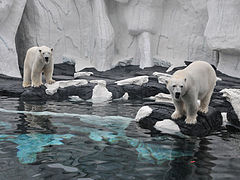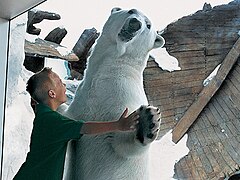Wild Arctic
| Wild Arctic | |
|---|---|
| SeaWorld Orlando | |
| Status | SBNO (Standing But Not Operating) |
| Opening date | 1995[1] |
| Replaced | Mission: Bermuda Triangle |
| SeaWorld San Diego | |
| Status | Removed |
| Opening date | 1997 |
| Closing date | January 10, 2020 |
| Replaced | Mission: Bermuda Triangle[2] |
| General statistics | |
| Attraction type | Cabin Simulator ride |
| Manufacturer | Reflectone, Inc. |
| Designer | SeaWorld Parks and Entertainment |
| Model | Motion simulator |
| Capacity | 1,416 riders per hour |
| Vehicle type | Motion Based Cabin |
| Vehicles | 3 (Orlando) 4 (San Diego) |
| Riders per vehicle | 59 |
| Rows | 6 |
| Riders per row | 9-10 |
| Audience capacity | 100 stationary seats. per show |
| Duration | 5:00 approx. |
| Height restriction | 42 in (107 cm) |
Wild Arctic is a motion simulation attraction at SeaWorld Orlando and previously at SeaWorld San Diego. The attraction is combined with an animal exhibit featuring beluga whales, walruses, and harbor seals. This attraction replaced Mission: Bermuda Triangle at both locations.
Guests have the option to ride on a non motion gyrostabilized helicopter, completely bypassing the motion simulation.[3] The same video that is played in the motion ride is played in the non motion theater, but watching is optional as guests can walk through the room at any time.
The ride was manufactured by Reflectone.[4] It uses the same motion technology as multi-million dollar commercial and military flight simulation training devices.
In 2019, SeaWorld announced on its Instagram page that the San Diego location would close on January 10, 2020.
When SeaWorld Orlando reopened in June 2020 after the COVID pandemic closure, Wild Arctic remained closed. The exhibit stayed open (containing all the animals), but the ride (and the non-motion theater) could not be accessed. As of January 2022, the ride has not announced a reopening date.
Attraction summary[]
Entrance[]
Guests queue outside the "Franklin Exploration Center", where it is presumed that they are waiting to board a helicopter which will take them to "Base Station: Wild Arctic". The queue outside the attraction includes numerous murals of the Arctic animals and scenery as well as various HD TV monitors that show various clips about the Arctic and its animals running on a loop. Guests then enter the show building.
Gate boarding rooms[]
Once inside the building, guests are divided into either traveling by helicopter (the ride portion) or traveling by foot / walking (in which they view the ride film without the motion). Guests who require stationary seating are taken directly to a Gate Boarding Room B where they view the ride film and then the interactive animal exhibit.
Guests experiencing the actual ride are taken into a room with an information board showing the flight departure schedule, as well as a large projection screen in front of them which shows another random clip about facts of the Arctic. From here, guests enter the pre-flight boarding station where they line up into multiple rows to prepare for their helicopter flight. Soon, a video comes on the screen in which the Operations Coordinator for the Franklin Exploration Center explains that the center is a support facility for Base Station Wild Arctic, and that both facilities were founded by Thomas Purcell in 1937, who strived to have man survive in the Arctic climate to research the area. The Coordinator further explains that guests will be traveling to Base Station Wild Arctic in the White Thunder helicopter. A brief restriction spiel is played before she then turns the show over to Co-Pilot Norm "Snowman" Miller, played by comedian/actor Rick Ducommun. Miller begins to explain that the White Thunder is being piloted by Captain Emerson, but is interrupted by White Thunder's computer, which warns of a severe arctic storm in their path. Miller then explains the safety rules to guests, and ends the video. The doors to White Thunder then open, and guests board the ride vehicle via a drawbridge-style ramp.
This pre-show has been removed as of 2018 in San Diego and has been updated with a new pre-show explaining animals in the attraction then turning to a crew member for safety information. The ride itself was not altered and stayed the same.[5]
Ride[]

Once guest have been seated and secured seat belts, the doors close, and Captain Emerson begins departing White Thunder from the Franklin Exploration Center, explaining to guests that he expects a short, comfortable flight to Base Station "Wild Arctic". Soon, Emerson begins flying the helicopter down to observe a polar bear family and then pilots White Thunder to switch to a water mode to dive into the Arctic waters to observe some Narwhals. Soon after the helicopter is piloted above water again, where Emerson warns that the Arctic storm is picking up and he has a warning indicator on his computer. Emerson lands the helicopter on a glacier to check the problem, which soon begins breaking apart due to the weight of the jet. Emerson struggles to get the engine to start, and the helicopter is soon caught in a rock slide before it begins flying again. The computer then dies out, and Emerson decides to use a shortcut to Base Station Wild Arctic to avoid the storm. Soon, White Thunder is caught in an avalanche and ice flow until Emerson narrowly escapes the storm by piloting through a narrow cavern, and to safety. The jet then arrives at Base Station Wild Arctic, and Emerson thanks guests and bids them farewell as they explore the research station. The doors then open, and guests exit the ride into Base Station Wild Arctic.
Post-show & exhibit[]

Polar bears

Beluga whales

Beluga whales under water
Following the ride, guests enter Base Station Wild Arctic, which consists of a re-created Arctic Research Station built around two sailing ships which are trapped in the ice. The story surrounding the ships are taken from the 1845 expedition of Captain John Franklin and his ships, HMS Erebus and HMS Terror. It has been one of the enduring mysteries of Arctic exploration: What happened to the two ships commanded by Captain John Franklin of Britain's Royal Navy after he set off in 1845 to find a route to Asia through the Northwest Passage? On September 7 the mystery was partially solved when an expedition led by the Canadian government found one of the ships, still relatively intact, resting on the bottom of Queen Maud Gulf in Canada’s Arctic. Numerous animals can be seen on exhibit at the base, including beluga whales, polar bears, walruses, and harbor seals. There are currently no polar bears at SeaWorld. There are also multiple interactive cameras and activities scattered throughout the station. At the end of the attraction, guests exit through a long series of ramps.
Gift shop[]
Following this area is a gift shop for the attraction where arctic-themed and SeaWorld-themed merchandise can be purchased.
References[]
- ^ "Polar Pair Quickly Melt Fans' Hearts At Sea World". tribunedigital-orlandosentinel. Retrieved June 4, 2016.
- ^ Jes McAdam-Sellers (February 28, 2014), The Making Of Mission: Bermuda Triangle, retrieved June 4, 2016
- ^ "Wild Arctic-". www.youtube.com. Retrieved June 4, 2016.
- ^ "Reflectone Inc". St. Petersburg Times. 1997. Retrieved November 23, 2013.
- ^ Huntscmac Mac (October 4, 2016), Wild Arctic Safety Preshow, retrieved March 30, 2018
- Amusement rides introduced in 1995
- Removed amusement attractions
- Amusement rides introduced in 1997
- Amusement rides that closed in 2020
- Amusement rides manufactured by Reflectone
- SeaWorld San Diego
- SeaWorld Orlando
- Simulator rides




